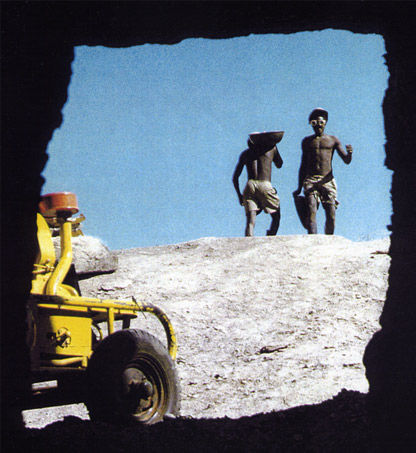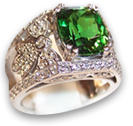Tsavorite and Today’s Market

Greeted by daylight at the entrance of Scorpion Mine tunnel number 4.
Obviously, a sufficient production of Tsavorite on a regular basis is required so that the market place will be interested in promoting Tsavorite in much the same way that Tanzanite (also named by Platt) was promoted.
Some dealers complain that there is an insufficient supply of Tsavorite for it to be a commercial gemstone and not just a connoisseur’s or collector’s rarity. It is true that it is a rare stone, being mined in fine gem quality only in East Africa. It is also correct that Tsavorite deposits are generally not very large or extensive but some of the known ones are either not well developed or not mined beyond a certain point, nor is large venture capital risked in locating new ones. Why is this? One factor alone; Tsavorite is under-priced! Mercedes Benz could neither develop nor expand if it had to sell its product for the price of a Volkswagen Beetle. Similarly, Tsavorite needs to fetch a fairer price if there is to be increased production. It is a true gemstone in every sense of the word yet it only sells for about one-fifth the price of an emerald even though rarer and superior in most of its physical properties. A long history has enabled emerald to reach a relatively accurate market price while Tsavorite has only been known to a limited segment of mankind for less than 50 years and, because of this lack of exposure, is still very undervalued. It therefore, has excellent investment potential.
If a diamond is set next to emerald in an anniversary ring, you have a brilliant spot followed by a relatively dull spot. The flow of the eye starts and stops. When diamond is followed by Tsavorite, the brilliance is continuous and the eye flows along the band from white to green fire. Using well cut Tsavorite together with diamonds in a piece of jewelry creates homogeneity in terms of brilliance and, hence, a truly dazzling effect. It is partly for this reason that a number of manufacturers of fine jewelry are now using Tsavorite in their diamond/coloured stone lines.
Why doesn’t it receive more exposure and publicity? One of the drawbacks is that many would sooner sell relatively-easy-to-replace emerald at many times the price of a more-difficult-to-replace Tsavorite. The same reasoning is found among gem firms who continue to romance emerald while neglecting or downplaying Tsavorite. Maybe this is for nostalgic reasons or, perhaps, they hold large stocks of emerald they wish to move at the much higher prices than Tsavorite commands at present. As justification, they correctly point out that emerald has been around for thousands of years and that it has been possessed and prized by Emperors, Kings, Queens, and Maharajahs. They say that Tsavorite is a new stone without a lengthy history.
Well, new in the marketplace it may be, but in terms of geological history it is extremely old. The rocks in which it formed were first laid down a couple of billion years ago in Pre-Cambrian times. The exotic shoreline of present day East Africa at that time lay far to the west and it was the clays, sands, and limestones deposited along that ancient shoreline that became the necessary strata so essential for the formation of Tsavorite. These rocks were subjected to tremendous heat and pressures during their genesis, and it was during one or more of these high metamorphic phases that Tsavorite came into being. It is interesting to note that the last of these major metamorphic phases is believed to have occurred some six to eight hundred million years ago. So Tsavorite is certainly not young!
As for romance, what could be more romantic than a superb flashing green gemstone that was in existence long before the dinosaurs trod the earth, and that lies in a mysterious land where the roar of the hunting lion still shatters the star-filled African night. It is a domain presided over by the mighty snow-capped Mt Kilimanjaro, the highest mountain in Africa at close to 6,000 meters and itself only in infancy when Tsavorite was already old. To the east lies the fine white coral sand beaches and waving coconut palms that fringe the blue-green crystal waters of the Indian Ocean.
Thus, Tsavorite is not without its romance and, being one of the most beautiful gems to come out of Africa since the dawn of time, it should not be long before this unique green precious stone is adding its sparkle to the happy eyes of jewelry lovers the world over.


